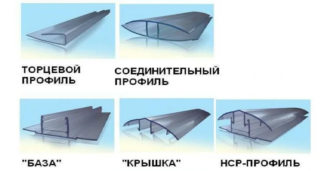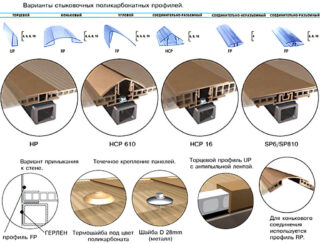The profile for polycarbonate helps to ensure the manufacturability of installation, ease of use of the structure, obtaining useful properties, and a finished appearance. Before purchasing material, you need to understand the types and purpose of various additional elements.
Purpose and advantages of use
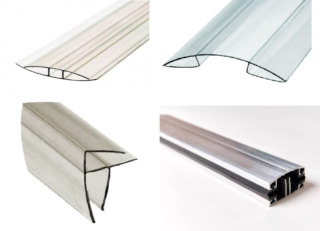
Cellular polycarbonate has standard dimensions: 210 cm in width and up to 12 m in length. The use of additional elements during the installation process allows:
- arrange abutments to various surfaces;
- dock 2 sheets together to prevent roof leaks;
- protect open cavities at the end of the element from dust and water;
- to give an attractive look to the places of the cuts that occur when adjusting the sizes;
- to minimize the influence of cold bridges.
Manufacturers produce a wide range of profiles to reduce the inconvenience of installation, to make the work easier, and the consumer properties of the structure are higher.
General classification and specifications
- production material - polycarbonate and aluminum;
- purpose - guides, connecting, docking elements, end, ridge, wall profiles, clamping strips, etc.;
- connection type - detachable, one-piece, sliding;
- connection angle - straight and angular, with variable geometry.
The technical characteristics important for the consumer include:
- length - profiles for longitudinal sides are usually made up to 6 m, end modifications 210 cm;
- the thickness of the panels for which the profile is intended - from 4 to 32 mm.
All polycarbonate joining profiles are flexible enough to be mounted with sheets of appropriate thickness and under permissible bending circles.
Profile types
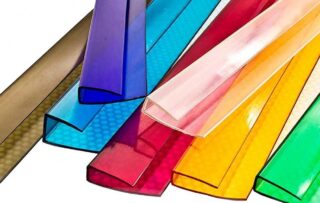
For cellular polycarbonate, profiles of the same material are more often used, for monolithic plates - aluminum. The metal type cannot be arbitrarily bent, therefore it is used only in flat building structures.
Parts that are different in purpose and design have identical markings from different manufacturers.
End profile
End profiles are needed to seal and clean the exposed sides of the carbonate sheet.
Products are marked U, UP or P, which roughly corresponds to the appearance of the cut. The edges of the profile are slightly bent inward, which ensures a secure fixation.
Some manufacturers produce a perforated version of products, which ensures the evaporation of condensate that has gotten into the cavities for any reason.
Connecting HP profile
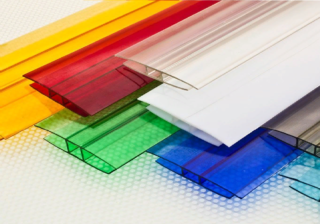
The HP polycarbonate connecting strip is used to join two sheets of honeycomb or monolithic polycarbonate. The flexibility of the part allows installation in one plane or for installation of panels in the form of an arch. An alternative designation for this type of profile is PSN.
HP marking shows that the profile is one-piece and is not intended for fixing sheets to the frame.The main purpose of the product is to seal the joint and prevent water leakage at the joint.
Manufacturing material - aluminum or plastic.
In the center of the docking bar for HP polycarbonate there is an unused cavity, through which self-tapping screws cannot be screwed to the frame.
Connecting HCP profile
The split profile for polycarbonate is marked with the Latin letters НСР or the Cyrillic letters PSRB. Consists of two parts.
The base-base (HCP-D) is screwed to the frame with self-tapping screws. Next, insert the polycarbonate sheets and snap the cover (HCP-U).
Connector for polycarbonate НСР provides:
- simple fastening of sheets to the frame;
- reliable fixation of panels;
- economical consumption of material, since in this case the sheets are placed end-to-end, and not in an overlap of 10 cm, which would reduce the working width of the sheet.
The price of the products is higher than the one-piece models, but they pay off due to the quick installation.
Docking profiles exclude the installation of overlapping sheets, therefore, they save at least 5% of the area.
Profile for monolithic polycarbonate is often chosen from aluminum.
Corner FR profile
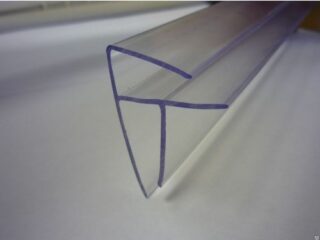
The most widespread is the right angle connector for polycarbonate. At the same time, some manufacturers produce products for docking at angles of 30, 45, and 60 °.
Designation FR. Corner pieces have increased strength and torsion resistance.
After installing the panels, the part is attached to the frame with self-tapping screws, ensuring the strength of the entire structure.
Wall-mounted FP profile
The starting or wall-mounted guide rail for FR polycarbonate is designed for the design of abutments to walls and other flat fixed structures. It has a structure that repeats the Latin letter F. One side of the profile is attached to the frame, and a panel is installed in the free edge. Thanks to this design, a tightness and tightness of the fit is ensured.
The product is used to decorate wall greenhouses, canopies and awnings.
Ridge RP profile
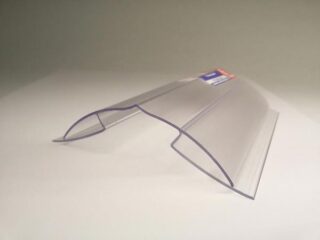
The polycarbonate docking ridge profile is designed to connect two sheets at the top of the building structure.
Consists of two end extensions, interconnected by a flexible partition. Due to the plasticity of the lintel, the sheets can be positioned at an angle of 30 to 70–80 ° relative to each other.
When the temperature changes, the baffle can change the angle of articulation within a small range, and then restore the original configuration. The property allows you to get a reliable tight connection.
Sliding
The product represents guides for polycarbonate, to the sheets of which movable carriages are attached.
The design is used in the glazing of balconies and loggias - an accidental fall of polycarbonate will not injure passers-by, the panels cannot be broken into dangerous fragments, which also reduces injuries compared to glass.
Clamping strips
For the tight fit of polycarbonate to the frame, aluminum clamping strips are sometimes used.
Rubber seals are installed in the aluminum parts, which reliably seal the panel joints. The strips are not intended for arched structures and are most often used in elements made of monolithic polycarbonate or honeycomb variety with a thickness of more than 16 mm.
Installation features
Incorrect technology may void your warranty.
Fundamental rules:
- When cutting, the panels are pressed tightly on both sides, which will eliminate vibration and cracking of the edge of the panel.
- The protective film is removed immediately before laying the polycarbonate.
- They work at plus temperatures from 10 to 25 ° С.In such conditions, it is easier to maintain the required clearances for thermal expansion and to exclude further deformation of the sheets during operation.
- When installing the frame, special attention should be paid to the distances between the supporting parts - they should be located exactly along the width of the sheets.
- Cellular polycarbonate must be positioned so that the voids are in a vertical position. This will allow the condensate to drain.
- An arched bend is made only perpendicular to the stiffening ribs.
- The UV-protected side is directed outward.
- Expansion shims are required for any type of aluminum profile. If you install the sheets without them, in hot weather, deformation and loss of appearance of the panel is possible.
- All types of profiles must exactly match the thickness of the sheets.
- Fastening is carried out with thermal washers, which isolate the cold bridges and ensure the integrity of the sheets during thermal expansion.
- Self-tapping screws with a rubber washer can be used in structures where leaks are not critical and there are no increased requirements for heat preservation.
- When tightening hardware, use screwdrivers with a load limiter and a dynamic brake in order to exclude the pushing of the cellular polycarbonate. The ratchet limit is set in advance.
- If the frame is made of thick-walled metal, it is recommended to drill holes in advance, this will prevent damage to the polycarbonate under accidental loads (bit slipping off, drill breakage, etc.). After fastening and setting the required position, continue to fix the sheet with a step of hardware of 50-60 cm, this is easy to do, since the polycarbonate is transparent and the drilled holes are clearly visible.
- In frames made of a profiled pipe, a hole is drilled only in one wall, and self-tapping screws are selected to the appropriate length.
- The open upper ends are sealed with silicone, closed with a profile. Another option is pasting with perforated metallized tape.
When installing detachable connections, a rubber mallet is used for snapping in to prevent damage to the panels and profile. The ends of the profiles are closed with plugs.

